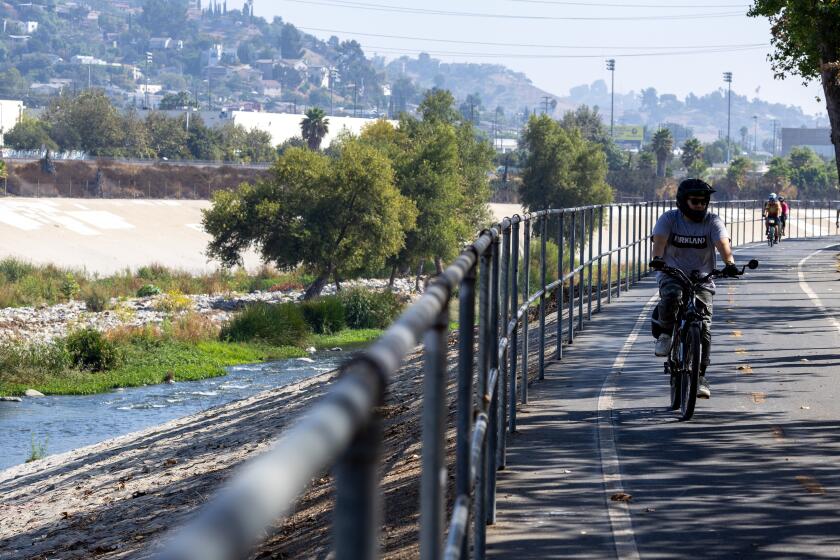A Mormon in the Holy Land
Mitt Romney’s visit to Israel will generate much speculation on the role Jewish voters will play in the U.S. presidential election. His visit may also spark discussion about Mormon-Jewish relations in the wake of the recent controversy over a Mormon temple that conducted posthumous baptism ceremonies for some Holocaust victims.
But another Mormon’s visit to Jerusalem, 99 years ago, deserves some of the spotlight too. Because that little-known visit ultimately had a decisive impact on Jewish history and America’s response to the Holocaust.
In 1913, 29-year-old Elbert Thomas and his wife, Edna, wrapped up their five-year stint in charge of a Mormon mission in Japan and prepared to return to their native Utah. They decided to pay a short visit to Turkish-occupied Palestine on the way home.
EDITORIAL: Romney pandering on the world stage
The Holy Land figures prominently in Mormon theological tracts. Thomas was keenly aware of Mormon prophecies about an ingathering of the Jewish exiles and the rebirth of the Jewish homeland.
“We sat one evening on the Mount of Olives and overlooked Jerusalem,” he later recalled. “We read the poetry and the prophecy, the forebodings and the prayers, with hearts that reached up to God.” Under “stars the likes of which you see nowhere else in the world but on our own American desert, out where I grew up,” Thomas read the lengthy “Prayer of Dedication on the Mount of Olives” by Orson Hyde, an early Mormon leader and fervent Christian Zionist.
“Consecrate this land … for the gathering together of Judah’s scattered remnants … for the building up of Jerusalem again after it has been trodden down by the Gentiles so long,” Hyde had written in 1841. “Restore the kingdom unto Israel, raise up Jerusalem as its capital…. Let that nation or people who shall take an active part in behalf of Abraham’s children, and in the raising of Jerusalem, find favor in Thy sight. Let not their enemies prevail against them … but let the glory of Israel overshadow them.”
COMMENTARY AND ANALYSIS: Presidential Election 2012
The moment, the mood and the words moved Thomas to feel a deep spiritual connection to the Jewish people and to commit himself to becoming one of those who would “take an active part in behalf of Abraham’s children.” And three decades later, he was presented with an opportunity to do so.
In the 1940s, as a U.S. senator from Utah, Thomas became deeply concerned about the plight of the Jews in Nazi Europe. He joined the Emergency Committee to Save the Jewish People of Europe, a lobbying group led by Jewish activist Peter Bergson. Thomas signed on to its full-page newspaper ads criticizing the Allies for abandoning European Jewry. He also co-chaired Bergson’s 1943 conference on the rescue of Jews, which challenged the Roosevelt administration’s claim that nothing could be done to help the Jews except winning the war. Although a loyal Democrat and New Dealer, the Utah senator boldly broke ranks with PresidentFranklin D. Roosevelt over the refugee issue.
Thomas played a key role in advancing a Bergson-initiated congressional resolution calling for creation of a government agency to rescue Jews from the Nazis. Sen. Tom Connally (D-Texas), chairman of the Senate Foreign Relations Committee, initially blocked consideration of the resolution. But when Connally took ill one day, Thomas, as acting chair, quickly introduced the measure. It passed unanimously.
Meanwhile, senior aides to Treasury Secretary Henry Morgenthau Jr. had discovered that State Department officials had been obstructing opportunities to rescue Jewish refugees. Morgenthau realized, as he told his staff, that the time had come to say to the president, “You have either got to move very fast, or the Congress of the United States will do it for you.” Armed with a devastating report prepared by his staff, and with congressional pressure mounting, Morgenthau went to FDR in January 1944.
Roosevelt could read the writing on the wall. With just days to go before the full Senate would act on the resolution, Roosevelt preempted Thomas and the other congressional advocates of rescue by unilaterally creating the agency they were demanding: the War Refugee Board.
Although understaffed and underfunded, the board played a major role in saving more than 200,000 Jews during the final 15 months of the war. Among other things, the board’s agents persuaded a young Swede, Raoul Wallenberg, to go to German-occupied Budapest in 1944. There, with the board’s financial backing, he undertook his now-famous rescue mission. Thomas’ action in the Senate was an indispensable part of the chain of events that led to Wallenberg’s mission.
The Swedish government, together with Holocaust institutions and Jewish communities around the world, recently launched a yearlong series of events commemorating this summer’s 100th anniversary of Wallenberg’s birth. One hopes these celebrations will include appropriate mention of the role played by Americans such as Thomas in making Wallenberg’s work possible.
And as Romney retraces some of Thomas’ steps in Jerusalem, he will have special reason to feel proud of the role played by a fellow Mormon in helping to save Jewish lives.
Rafael Medoff is director of the David S. Wyman Institute for Holocaust Studies and the coauthor with Sonja Schoepf Wentling of the new book “Herbert Hoover and the Jews: The Origins of the ‘Jewish Vote’ and Bipartisan Support for Israel.”
More to Read
A cure for the common opinion
Get thought-provoking perspectives with our weekly newsletter.
You may occasionally receive promotional content from the Los Angeles Times.










